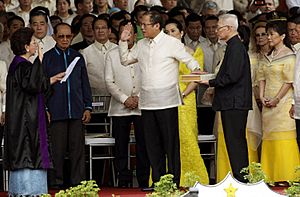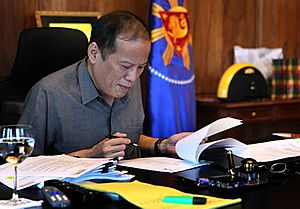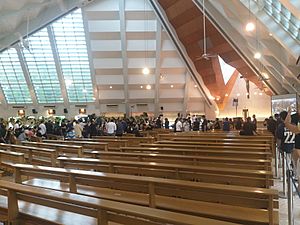Benigno Aquino III facts for kids
Quick facts for kids
Benigno S. Aquino III
KGCR
|
|
|---|---|
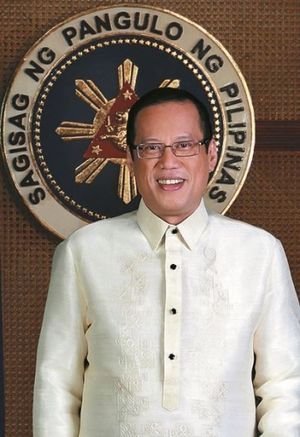
Official portrait, 2010
|
|
| 15th President of the Philippines | |
| In office June 30, 2010 – June 30, 2016 |
|
| Vice President | Jejomar Binay |
| Preceded by | Gloria Macapagal Arroyo |
| Succeeded by | Rodrigo Roa Duterte |
| Secretary of the Interior and Local Government | |
|
Officer-In-Charge
(in concurrent capacity as President of the Philippines) |
|
| In office June 30, 2010 – July 9, 2010 |
|
| Preceded by | Ronaldo Puno |
| Succeeded by | Jesse Robredo |
| Senator of the Philippines | |
| In office June 30, 2007 – June 30, 2010 |
|
| Senate President |
|
| Deputy Speaker of the House of Representatives of the Philippines | |
| In office November 8, 2004 – February 21, 2006 |
|
| Preceded by | Raul M. Gonzalez |
| Succeeded by | Simeon Datumanong |
| Member of the Philippine House of Representatives from Tarlac's 2nd district | |
| In office June 30, 1998 – June 30, 2007 |
|
| Preceded by | Jose Yap |
| Succeeded by | Jose Yap |
| Personal details | |
| Born |
Benigno Simeon Cojuangco Aquino III
February 8, 1960 Sampaloc, Manila, Philippines |
| Died | June 24, 2021 (aged 61) Quezon City, Philippines |
| Resting place | Manila Memorial Park – Sucat, Parañaque, Philippines |
| Political party | Liberal |
| Parents |
|
| Relatives |
|
| Alma mater | Ateneo de Manila University (A.B.) |
| Signature |  |
| Nicknames | PNoy, Noynoy |
Benigno Simeon Cojuangco Aquino III (February 8, 1960 – June 24, 2021), also known as Noynoy Aquino and colloquially as PNoy, was a Filipino politician who served as the 15th president of the Philippines from 2010 to 2016.
Under Aquino's presidency, the nation's economy grew at the highest rates in decades, and the country was dubbed a "Rising Tiger" economy. Known for his confrontational foreign policy, his administration filed an arbitration case, Philippines v. China, before the Permanent Court of Arbitration in an attempt to invalidate China's claims in the South China Sea and assert the Philippines' claims in the area; the court ruled in favor of the Philippines. His term ended on June 30, 2016, and he was succeeded by Rodrigo Duterte.
After leaving office, Aquino was the subject of legal actions over his role in the Mamasapano clash and for approval of a controversial budget project; he was later acquitted of all charges filed against him regarding the Mamasapano incident.
Contents
Early life and education
Noynoy Aquino was born as Benigno Simeon Cojuangco Aquino III on February 8, 1960, at Far Eastern University Hospital in Sampaloc, Manila. He is the third of the five children of Benigno Aquino Jr., who was then the vice governor of Tarlac, and Corazon Cojuangco, daughter of prominent Tarlac businessman José Cojuangco. He has four sisters, namely: Maria Elena, Aurora Corazon, Victoria Elisa, and actress Kristina Bernadette. He attended the Ateneo de Manila University in Quezon City for his elementary, high school, and college education.
Aquino finished his Bachelor of Arts (major in economics) degree from the Ateneo in 1981.

From 1993 to 1998, he worked for Central Azucarera de Tarlac, the sugar refinery in the Cojuangco-owned Hacienda Luisita. He was employed as the executive assistant for administration from 1993 to 1996 and subsequently worked as manager for field services from 1996 to 1998.
Early political career
Aquino was a fourth-generation politician: his great-grandfather, Servillano "Mianong" Aquino, served as a delegate to the Malolos Congress; his paternal grandfather, Benigno Aquino Sr., served as Speaker of the National Assembly from 1943 to 1944; his maternal grandfather, José Cojuangco, was also a member of the House of Representatives; and his parents were Corazon Aquino, who served as the 11th president of the Philippines (1986–1992), and Senator Benigno "Ninoy" Aquino Jr. Aquino was a member of the Liberal Party, where he held various positions such as secretary general and vice president for Luzon.
Benigno Aquino III served as a member of the House of Representatives and Senate from 1998 to 2010, and also as a deputy speaker of the House of Representatives from 2004 to 2006. On September 9, 2009, shortly after the death of his mother, he announced his candidacy in the 2010 presidential election, which he eventually won. He was sworn into office as the 15th president of the Philippines on June 30, 2010, succeeding Gloria Macapagal Arroyo.
Presidency (2010–2016)
Early years
The presidency of Benigno Aquino III began at noon on June 30, 2010, when he became the fifteenth president of the Philippines, succeeding Gloria Macapagal Arroyo. From the start of his presidency on, he was also referred to in the media as PNoy.
The presidential transition began on June 9, 2010, when the Congress of the Philippines proclaimed Aquino the winner of the 2010 Philippine presidential elections held on May 10, 2010, proclaiming Aquino as the president-elect of the Philippines. The transition was in charge of the new presidential residence, cabinet appointments, and cordial meetings between themselves and the outgoing administration. Aquino took residence in the Bahay Pangarap, the first president to do so, instead of the Malacañang Palace, which has been the official residence of his predecessors.
Aquino also announced the formation of a truth commission that would investigate various issues including corruption allegations against his predecessor President Gloria Macapagal Arroyo with former Chief Justice Hilario Davide Jr. as commission head.
Aquino took the oath of office on June 30, 2010, at the Quirino Grandstand in Rizal Park, Manila. The oath of office was administered by Associate Justice Conchita Carpio-Morales, who officially accepted Aquino's request to swear him into office, reminiscent of the decision of his mother, who in 1986, was sworn into the presidency by Associate Justice Claudio Teehankee. After being sworn in as the fifteenth president of the Philippines, succeeding Gloria Macapagal Arroyo, Aquino delivered his inaugural address.
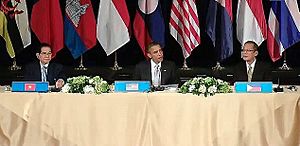
On July 26, 2010, at the Batasang Pambansa, in Quezon City, Aquino delivered his first State of the Nation Address (SONA). During Aquino's first State of the Nation Address (SONA), Aquino announced his intention to reform the education system in the Philippines by shifting to K–12 education, a 12-year basic education cycle. K–12 education is used in the United States, Canada, and Australia. On July 29, 2015, Aquino delivered his final SONA address, where he discussed the country's economic improvements and the benefits of social service programs, particularly the Pantawid Pamilyang Pilipino Program and the Philippine Health Insurance Corporation, during the course of his presidency.
Domestic policy
No wang wang policy
During the inaugural address, Aquino created the "no wang-wang" policy, strengthening the implementation of Presidential Decree No. 96. Wang-wang is colloquial term for blaring sirens. The decree was issued on January 13, 1973, by then President Ferdinand Marcos, regulating the use of sirens and other similar devices only to motor vehicles designated for the use of select national government officials, the police, the military, the fire department and ambulances. Despite having the privilege of using wang-wang as president, Aquino refrained from using sirens to set up an example for his policy, even if it means being stuck in traffic and being late every now and then. After the inaugural address, the Metropolitan Manila Development Authority began to enforce Aquino's no wang-wang policy, confiscating wang-wang from public officials and private motorists who illegally used them.
Bangsamoro peace process
Aquino resumed stalled peace talks with the Moro Islamic Liberation Front (MILF), a rebel group in Mindanao seeking self-determination for Moros. He met with the MILF in Tokyo, Japan in August 2011 to initiate peace talks which resulted to the signing of the Framework Agreement on the Bangsamoro between the Philippine government and the rebel group the following year. The agreement started the process of replacing the Autonomous Region in Muslim Mindanao (ARMM) with a new political entity. In 2014, the Comprehensive Agreement on the Bangsamoro (CAB) was signed between the Philippine government and the MILF, with the deal characterized as a "final peace agreement" between the two parties.
The CAB paved way for the drafting of the Bangsamoro Basic Law (BBL; later known as the Bangsamoro Organic Law or BOL), a charter for a proposed Bangsamoro autonomous region which would replace the ARMM.
In 2015, President Aquino was accused of evading responsibility for the Mamasapano clash, a botched police operation, which resulted to the death of 44 Special Action Force officers. He was also criticized for entrusting the operation to suspended police chief Alan Purisima. This led to a decrease of public support for the BBL.
Education
Aquino introduced reforms on the Philippine education program by introducing the K-12 curriculum by signing into law the Enhanced Basic Education Act in 2013. This added two years to the basic education system; which became known as the Senior High School stage. The program was introduced because the Philippines was among the three countries in the world at that time still had a 10-year basic education program. Among the criticisms of the K-12 program is the associated costs to be shouldered by teachers, parents, and students for the additional two years of basic education as well as the lack of classrooms and teachers required for the implementation of the shift to K-12.
Foreign policy
Benigno Aquino III is noted for his confrontational foreign policy against China, especially concerning the Philippines' approach in pursuing its claims in the South China Sea. It was under his administration, that the China v. Philippines case was filed in the Permanent Court of Arbitration (PCA) which ruled in 2016 the invalidity of China's nine-dash line claim which covers the entire sea, although China continues to disregard the decision. The case was filed in 2013, after the Philippines lost control of the Scarborough Shoal after the 2012 standoff with China over the dispute feature. He is also responsible for instituting the term "West Philippine Sea" in 2012 for the eastern parts of the South China Sea which the Philippines claims to be part of its exclusive economic zone.
Post-presidency (2016–2021)
Following the turnover ceremonies to his successor Rodrigo Duterte at Malacañang, Aquino returned to his parents' residence along Times Street, Quezon City. After leaving office, Aquino remained silent on the Duterte administration and rarely made public appearances. However, in November 2016, Aquino attended a concert at Rizal Park and joined protests against the burial of Ferdinand Marcos. In February 2017, Aquino commemorated the 31st anniversary of the People Power Revolution by marching to the People Power Monument and joining the protests against the Ferdinand Marcos regime.
Illness and death
Speculation surrounding Aquino's health began circulating in August 2019 after he was unable to attend the commemoration of his late father's 36th death anniversary; however, his spokesperson Abigail Valte said that his illness then was "nothing serious". In November 2019, Aquino was reported to have suffered from pneumonia. A month after, he was confined at Makati Medical Center for an executive checkup and undisclosed routine procedures. Aquino was confined in an intensive care unit, although according to his spokesperson, he was never in critical condition and the accommodation was just to limit visitors. Senator Francis Pangilinan, who was Aquino's former food security czar, later stated that this confinement was due to a kidney malfunction. Pangilinan added that Aquino had also been suffering from hypertension and diabetes. Thereafter, Aquino regularly sought medical treatment for his condition. By May 2021, Aquino told Camille Elemia of Rappler that he was experiencing a loss of appetite and breathing difficulties. That same month, he reportedly underwent a cardiac surgery.
In the early hours of June 24, 2021, Aquino was found by his maidservant lying unconscious on his recliner at his home in West Triangle, Quezon City. He was immediately transported by ambulance to the nearby Capitol Medical Center in Diliman, where he was pronounced dead at 6:30 a.m. (PHT), that day (22:30 UTC of the previous day). The cause of death was stated as renal disease, secondary to diabetes. According to his personal chauffeur, Aquino was scheduled to undergo dialysis on June 21, but refused because he felt that his body was "weak". Another dialysis was planned the day prior to his death, but Aquino again turned it down for similar reasons. Aquino's former public works secretary, Rogelio Singson, stated that he also underwent angioplasty to prepare for a scheduled kidney transplantation; Aquino was in the process of searching for donors at the time of his death.
His remains were cremated on the day of his death and his ashes were buried adjacent to that of his parents at the Manila Memorial Park in Parañaque on June 26, making him the first Philippine president to have been cremated. Three Masses were held on June 25–26 at the Church of the Gesù at his alma mater, the Ateneo de Manila University, where a public viewing was also held. Manila Archbishop Jose Advincula blessed his remains, while his funeral mass was presided over by Lingayen–Dagupan Archbishop Socrates Villegas (who also presided the requiem mass for Aquino's mother in 2009 when Villegas was Bishop of Balanga), with Caloocan Bishop Pablo Virgilio David concelebrating.
A few hours after the announcement of Aquino's death, President Rodrigo Duterte declared a ten-day "period of national mourning" from June 24 to July 3. All national flags were flown at half-mast as a sign of mourning.
The funeral rites of Aquino were covered by Radyo Katipunan, the radio arm of his alma mater, for the wake and Radio Television Malacañang for his burial.
Honors and awards
This is a list of honors and awards received by Benigno Aquino III.
Foreign honors
National Honors:
Honorary degrees
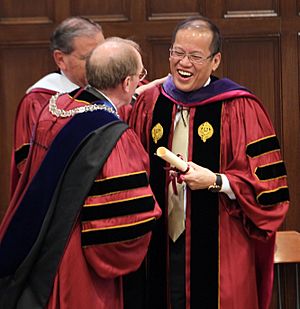
- Fordham University – Honorary doctoral degree in Economics (September 19, 2011)
- Centro Escolar University – Honorary doctoral degree in Economics (April 11, 2012)
- Kasetsart University – Honorary doctoral degree in Economics
- University of the Philippines Diliman – Honorary doctoral degree in Law
- Sophia University – Honorary doctoral degree in Law (December 13, 2014)
- Tarlac State University – Honorary doctoral degree in Humanities (May 14, 2015)
- Loyola Marymount University – Honorary Doctor of Humane Letters degree (February 17, 2016)
Recognitions
- Named one of the 100 Most Influential People in the World in 2013 by Time
- United States: City Council Resolution on welcoming the President to Chicago presented by Mayor Rahm Emanuel (May 6, 2015)
Images for kids
See also
 In Spanish: Benigno Aquino III para niños
In Spanish: Benigno Aquino III para niños


